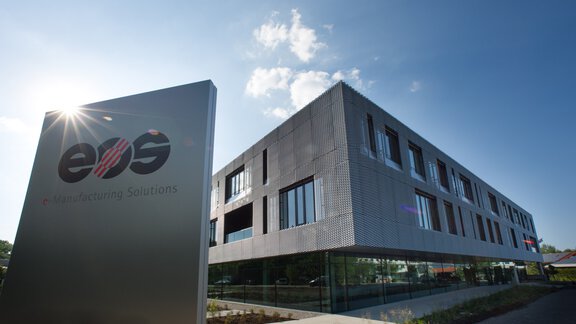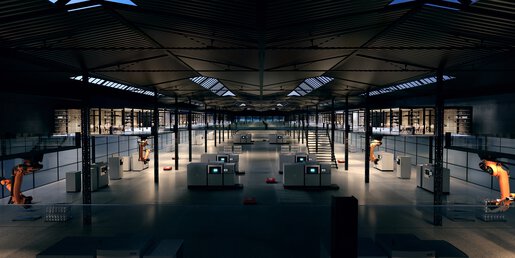The role of additive manufacturing in the fields of individualization, mobility, and globalization.
Individualization, mobility and globalization are trends shaping today’s world and will continue to do so in the years to come – particularly against the backdrop of digital transformation. They are shifting the way we live together, driving economic change, and are the basis for new business models as well as the markets of the future. At the same time, technological advancements often form the foundation needed for new trends to emerge.
One of these technologies is industrial 3D printing, also known as additive manufacturing (AM) – a process by which digital 3D design data is used to build up a component in layers by depositing materials. The geometric possibilities of this technology are practically unlimited.
We want to examine what this means for the following three trends:
1. Individualization – a Mass Market for Individual Products
Individualization covers a number of developments, including the consumer demand for “mass customization.” The increased desire for individualized, mass-produced products that meet a specific person’s needs is a growing market, which can be ideally served by Additive Manufacturing technology. In 3D printing, it makes no difference whether 50 identical or 50 individual parts are manufactured in one build cycle, making it possible to create highly personalized goods, even in serial production.
In general, made-to-measure products should be manufactured efficiently, cost-effectively, and ideally as close as possible to the market where they will be offered. One example is the healthcare sector, which offers solutions that meet a patient’s needs through digitalization. This ranges from telemedicine, which can ensure comprehensive care by qualified doctors, especially in rural regions, to wearables for therapy monitoring and control that simplify diagnosis and enable individual medication and dosage.
There is a great demand for these products. The WHO estimates that there are one billion people with some form of disability worldwide. Around 200 million people need glasses or other low-vision devices and do not have access to them; 70 million people need a wheelchair, whereas only five to 15 percent of them actually have one (Source: WHO). With all the possibilities it offers, industrial 3D printing can be part of the solution – particularly for individualized patient care – as each person is unique and standard solutions often fall short. Custom-made products based on traditional manufacturing processes are comparatively time-consuming and cost-intensive to produce.
3D printing addresses these challenges and enables high-quality, patient-specific orthopedic technology to be produced rapidly and cost-effectively. Patients are provided with products ideally adapted to their physical characteristics and specifications, which increases wearing comfort and ultimately ensures optimal treatment outcomes.
A further advantage of AM technology is the simple reproducibility of the components, as once designed, an orthosis can be produced again at any time and in the same quality. That is relevant, for example, for children’s orthoses, which have to be replaced with the same functionality and structure, but in a different size. Additive manufacturing is therefore among the key technological innovations worldwide for the medical sector. According to SmarTech Analysis, the market for industrial 3D printing solutions in the healthcare sector is expected to exceed nine billion US dollars by 2024 (Quelle: SmarTech Analysis).
2. Mobility: New Concepts Call for New Design Approaches
Constant accessibility, the ability to work from any location, the continual expansion of e-commerce with ever-shorter delivery and response times: The mobility trend offers a fully flexible way of living and embraces just about every aspect of life. It is complex to find suitable solutions for these growing mobility needs. For instance, mobility models include car sharing, e-mobility, autonomous driving, and so-called micromobility.
Futurologists predict that metropolitan areas will soon feature a close-knit network of so-called public-private vehicles and microcarriers such as electric scooters, autonomous shuttle vehicles, bicycles, and other miniature mobile facilities that are combined to form a network. Apart from the technical and ecological advantages, these new forms of mobility are based on completely new design concepts, opening up a new world of possibilities for automotive manufacturers, which need to adopt new ways of thinking at the same time.
One answer to these new approaches, for example in car body manufacturing, is industrial 3D printing. The technology begins where design and manufacturing need to be rethought. It enables a design-driven manufacturing process – in which a new way of thinking becomes a core element of the process. Companies can not only mass-produce personalized components without additional cost, but also manufacture complete assemblies both quickly and cost-effectively. Components can be easily modified right at the product development stage, both digitally and physically, simply by adjusting and “printing” the 3D data. Development cycles can be reduced to a minimum and sustainable product innovations rapidly implemented at lower cost. Comprehensive functional integrations such as springs or hinge joints can be directly designed into the component. Complicated structures can be created without the need for tools, and subcomponents can be reduced to a minimum.
Even complex designs or geometric shapes can be manufactured using 3D printing and a broad range of metals and polymers are available as materials. This is yet another reason why SmarTech Analysis estimates the market potential for industrial 3D printing solutions in the automotive sector worldwide at over six billion US dollars by 2024.
3. Globalization: Location and Time are Critical
One aspect of globalization to consider is the site selection of companies. It is becoming apparent that companies are increasingly pursuing the aim of operating and manufacturing in closer proximity to their sales markets. This trend towards “nearshoring” is also being taken up by 3D printing, as additive manufacturing provides an outstanding level of flexibility – with respect to production batch sizes, manufacturing times, and production locations. In future, components will no longer have to be made on a local-to-global basis and it will no longer be necessary to relocate production to low-cost countries, for example. Instead, decentralized manufacturing centers can be set up, the digital component data sent to them, and the product 3D-printed directly on site on a “globally local” basis, cutting logistics costs and reducing carbon emissions at the same time.
Two further advantages: additive manufacturing makes it possible to produce variable batches as needed (“from one to many) - and this from just-in-time, to on-demand, whatever needed. Small, individualized production batch sizes are a key advantage, particularly in the spare parts business, as they eliminate tool costs and cut the cost of warehousing.
The above developments are an important topic in the public transport sector, for example at Deutsche Bahn, as the company has decided to go with made-to-measure 3D-printed spare parts for the information panels in its ICE intercity trains. These kinds of small components in particular can be a great challenge to provide. Normal wear and tear as well as brittleness can cause parts to break over time and a replacement is frequently needed after 10 to 15 years. The intended service life of rail vehicles is at least 25 years. However, it is not uncommon for a train to be in use for far longer periods. In many cases, the supplier has long since decided to discontinue part production. In addition, it is often made in small quantities that cannot be reproduced economically with conventional manufacturing technologies.
Industrial 3D printing has the advantage of being able to produce new spare parts at any time, even for what are sometimes small quantities, thus guaranteeing decades of maintenance, without having to compromise on either quality or efficiency. At the same time the costs are lower than if tools had to be made for a conventional manufacturing process.
Industrial 3D Printing in the Digital Factory
At a time where every aspect is being influenced by digitization, 3D printing will continue to gain momentum. The digital factory is about standardizing proven methods, processes and resources to enable them to be reused in new products or models. For this reason,, the various steps in the process are interlinked to ensure a continuous flow of products and data.
The digital factory is high on the agenda for every company. In this context, industrial 3D printing plays a key role alongside technologies such as sensor technology, robotics, or machine-to-machine-to-human communication, making AM technology itself a trend and an element driving the digital transformation of society as a whole.
Contact







